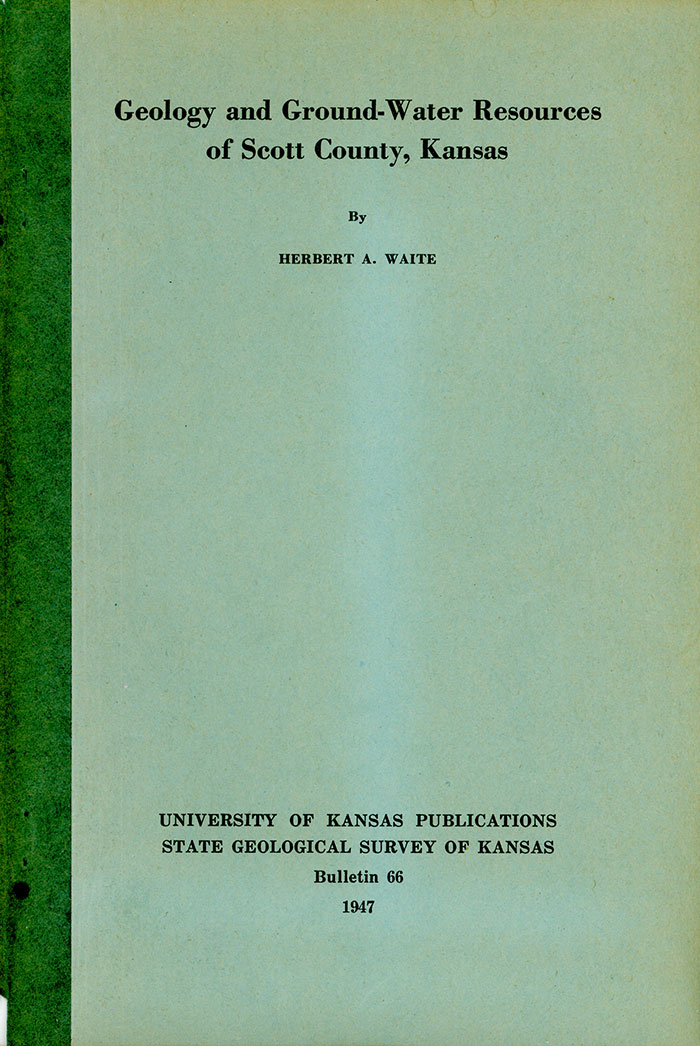Geology and Ground-water Resources of Scott County, Kansas
by Herbert A. Waite, U.S. Geological Survey

Originally published in 1947 as Kansas Geological Survey Bulletin 66. This is, in general, the original text as published in 1947. The information has not been updated. An Acrobat PDF version (63 MB) is also available.
You may also wish to visit our web site on the Scott County geologic map.
Abstract
This report describes the geography, geology, and ground-water resources of Scott County in southwestern Kansas. Scott County embraces a total of 723 square miles, and had a population of 3,769 in 1945. About 85 percent of the county consists of upland plains and the remainder of stream floodplains and intermediate slopes. It is drained by Beaver (Ladder) Creek in the northwestern part of the county and by tributaries of Smoky Hill River in the northern part. The most unusual topographic feature is the large depressional area southeast of Scott City at the terminus of Whitewoman Creek known as the Scott Basin—a part of a broad shallow asymmetrical depression extending southward into the Finney Basin in Finney County. The climate is semiarid, the average annual precipitation being about 20 inches. Wheat farming, some cattle raising, and general farming are the principal occupations in the area. Irrigation is practiced extensively in the Scott Basin.
The exposed rocks are sedimentary and range in age from Upper Cretaceous to Recent. A map showing the rock formations that crop out in the county is included with the report. Most of the county is underlain by Quaternary and Tertiary sands and gravels. In the northern part of the county tributary streams have cut below the Tertiary sediments and exposed Cretaceous shales and limestones (Niobrara formation). In the southeastern part of the county, the presence of a Cretaceous bedrock high is revealed by exposures of chalk and chalky shale of the Niobrara in shallow draws tributary to Dry Lake, an undrained depressional area near the southeastern corner of the county.
The principal water-bearing formations in Scott County are the Pliocene (Ogallala formation) and undifferentiated Pleistocene deposits. A few wells obtain water from shallow alluvium along the principal stream valleys and a few others obtain water from the Niobrara formation in the southeastern quarter of the county.
The report contains a map of the area showing by means of shading the depth to water level. The water table ranges in depth from less than 25 feet to about 160 feet in the upland areas in the northern part of the county. A map showing the shape and slope of the water table by contours is also included with the report. This map shows that ground water moves through Scott County in an easterly direction, the average slope being about 10 feet to the mile in the northern half of the county and about 6 feet to the mile in the southern part of the county in the vicinity of Shallow Water. In the northeastern quarter of the county the contours show that the water table slopes northeastward, and in the southeastern part of the county the contours show that the direction of movement is in a southeast direction. The contours also show that a cone of depression exists in the vicinity of the heavily pumped area southwest of Scott City.
The ground-water reservoir is recharged principally by precipitation that falls within the area, by the addition of water from flood runoff from Whitewoman Creek that spreads out at its terminus onto the floor of the Scott Basin, and by ground water moving in from adjacent areas. Ground water is discharged from the ground-water reservoir by pumpage from wells; by movement eastward, northeastward, and southeastward into adjacent areas; by evaporation and transpiration in areas of shallow water table; and by seepage into Beaver (Ladder) Creek and other tributary streams in the northern part of the county. All of the domestic, stock, public, industrial, and irrigation water supplies are obtained from wells.
Most of the wells in the area are drilled, but a few are dug. Records of 131 irrigation wells in Scott County were obtained. In 1945 a total of 129 wells supplied 18,400 acre-feet of water to irrigate 21,002 acres of land.
The ground water in Scott County, although generally hard, is suitable for most ordinary uses. The waters from the Pliocene (Ogallala formation) and undifferentiated Pleistocene deposits are similar in composition and hardness. Water from the alluvium was slightly harder than from the two sources mentioned above.
The field data upon which most of this report is based are given in tables, which include records of 282 wells and springs and chemical analyses from 29 representative wells and one typical spring. Logs of 77 test holes, water wells, and oil and gas wells in or adjacent to the county, including 23 test holes put down by the State Geological Survey, are given.
Kansas Geological Survey, Geology
Comments to webadmin@kgs.ku.edu
Web version March 2003. Original publication date July 1947.
URL=http://www.kgs.ku.edu/General/Geology/Scott/index.html